
When it comes to learning songs and memorizing music efficiently, there is a simple principle to follow.
Practice each note as many times as you need to learn it. No more, no less.

Pretty simple and kind of obvious, right?
Yet many musicians don’t follow this principle at all when they practice music and try to memorize a song. Often, we play the beginning way more than we do later parts of a song or piece of music.
In this article I’ll show you why that is. I’ll also show you a technique to memorize music that will turn your music practice on its head. I'll explain how you can memorize a song faster by starting at the end and working your way to the beginning of the song.
It’s an approach that is used by many classical musicians, but I rarely hear about it from players in other genres. That's a shame, because it really does make practice a lot more efficient, which simply helps you become a better musician faster. It's been my secret weapon for learning new music for years, ever since I found out about it.
Three Strategies
You may be thinking: why would it even matter where I start? Indulge me and my geeky calculations for a minute. Let’s go through three strategies and see what happens.
Let’s say you want to learn a 20-second solo. We’ll divide it into five phrases. Now, some of these phrases are more difficult and require more practice than others to master and remember them. Let’s say:
Phrase A: 2 tries Phrase B: 2 tries Phrase C: 5 tries Phrase D: 2 tries Phrase E: 3 tries
(Note: a phrase can be whatever chunk of music is small enough for you to focus on. It can be just one note, a chord, or a group of notes or chords.)
Forward Strategy 1
The strategy many musicians seem to use, is to start with phrase A. When they’ve mastered that, they play phrase A and then phrase B. Next, they play A, B, C and so on. Their practice session would look something like this:
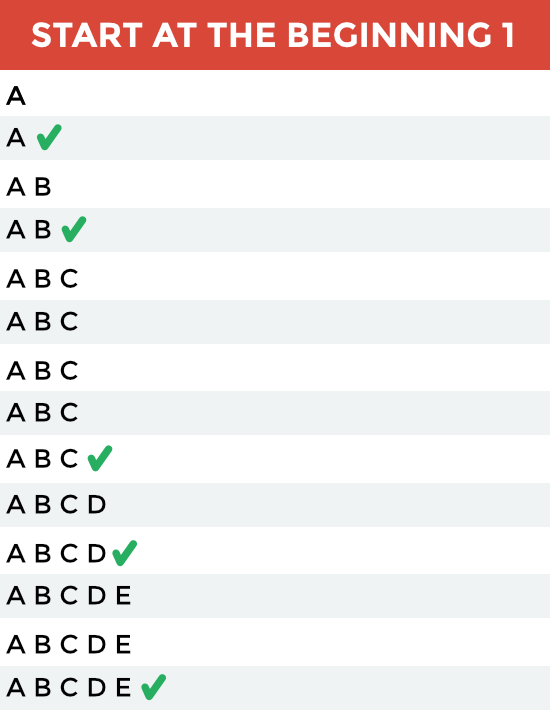
Phrases played: 44 Practice runs: 14
You might have spotted the problem with this: they’re playing all the phrases they’ve already mastered every single practice run. You need to go through these familiar phrases, before you get to the part you actually want to practice.
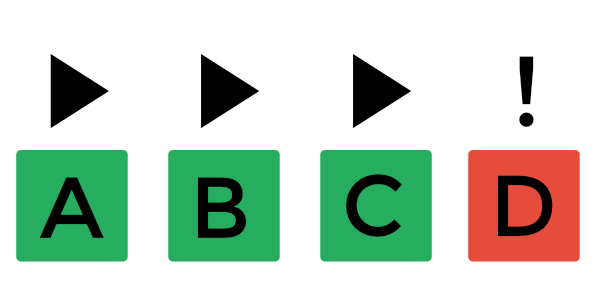
This is not just a waste of time, it can also become a bit of a drag to keep playing those same notes over and over again.
Forward Strategy 2
There’s an obvious solution to this, right? Don’t play those other parts first. Focus on each phrase individually and when you get it right, connect all the phrases. That would look like this:
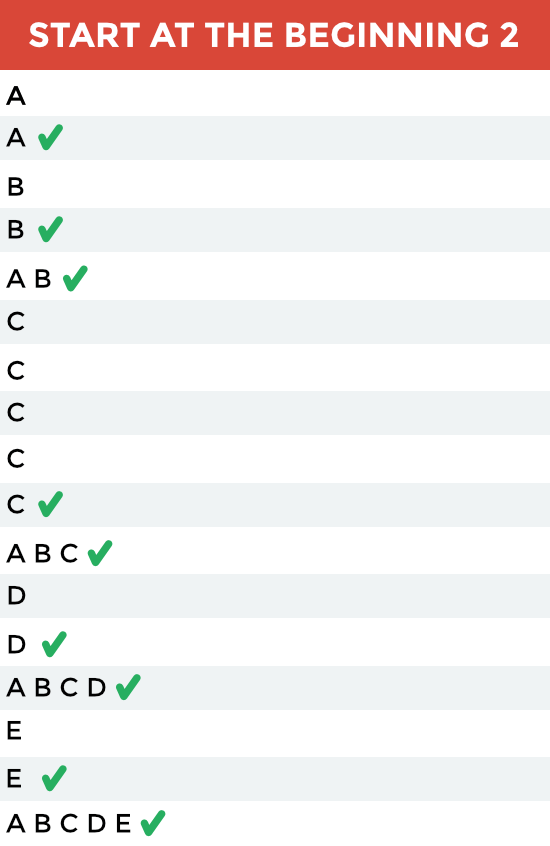
Phrases played: 28 Practice runs: 18
This is already a much more efficient approach. You aren’t wasting time on parts you already know, but focusing on what you need to practice.
The downside is that you need an extra practice run to connect the parts as the double check marks indicate. Not a huge problem, but it does take four more practice runs in total. (Spoiler: you don't need this extra run in the practice backwards approach.)
The second thing that makes this approach less than perfect, is that it requires a lot of discipline to stick to a single phrase and only play the other parts after you get that new phrase right. In my experience, it’s easy to get bored or sidetracked and start playing parts you already know.
The advantages of practicing music backwards
That brings us to my favourite approach: the practice music backwards strategy. Let's take a look at what a backwards practice session might look like and what the three main advantages are.
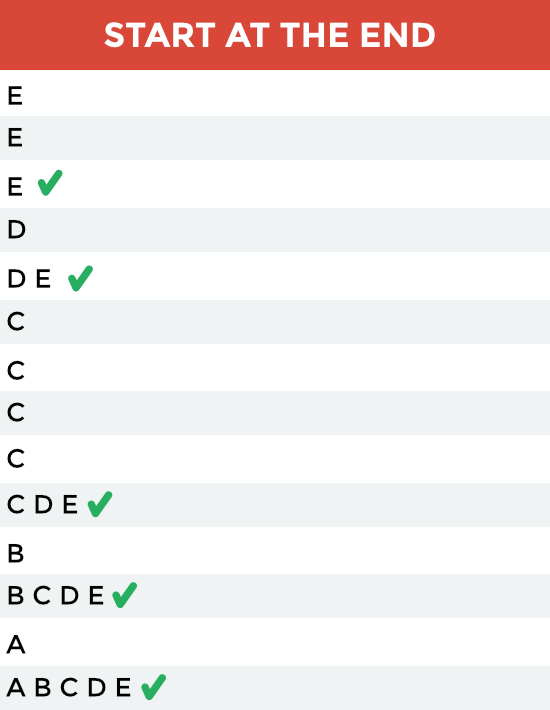
Phrases played: 24 Practice runs: 14
1. It’s efficient
As you can see, using this approach, you’ll be playing the least amount of phrases and practice runs. In strategy 1 you play 44 phrases, versus only 24 in the backwards approach. In other words, if you're using the approach that most people use, you could be learning a piece almost twice as fast, with half the effort.
So what causes this difference? In the start-at-the-start strategy, you’re wasting a lot of time by repeating parts you’ve already mastered, before practicing a new part.
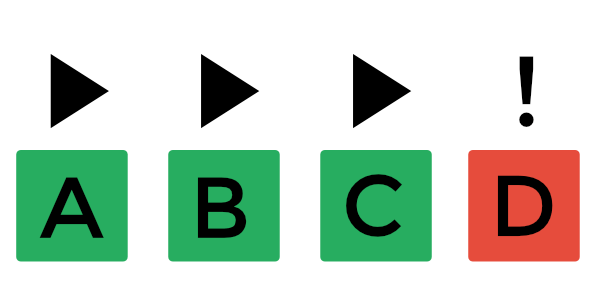
But in the backwards version you’re always starting with the least familiar part. And you only play the parts you already know, when you’ve succeeded at playing the new part. That new part is like a gatekeeper. It only allows you to repeat parts when you’ve gotten that newest and hardest part right.
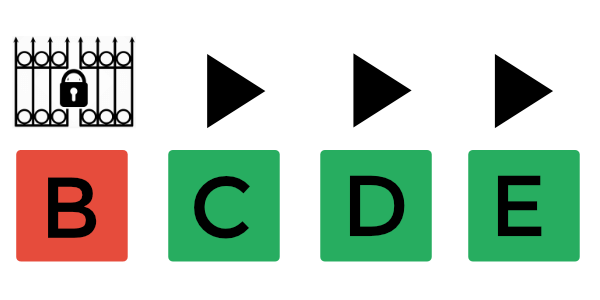
In short, the backwards strategy is a super effective way of identifying problem areas and focusing just the right amount of attention on them before moving on.
2. Your practice is more even
Ever had a piece where you knew the beginning really well, but your memory and mastery of the piece seemed to get worse and worse as you got further into the song? The cause of this annoying phenomenon is that you’ve played some parts more than others. Your practice is distributed unevenly among the piece. Here’s the number of times you play each phrase correctly in the start-at-the-start approach.
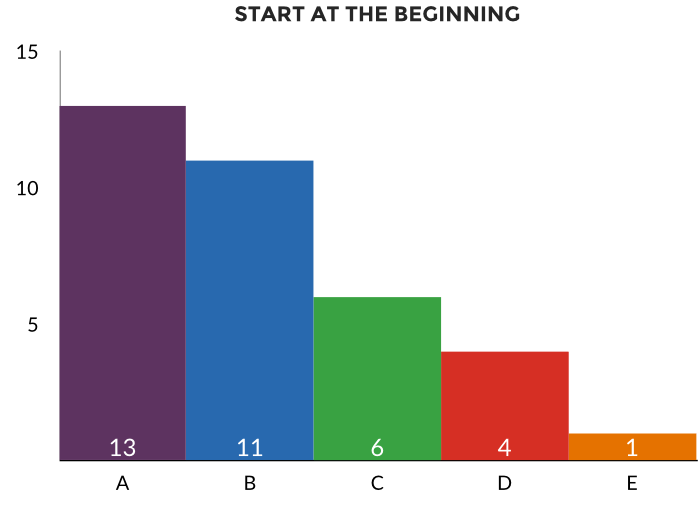
In this start-at-the-start version, you’ve played phrase A correctly twelve times more than phrase E. That means you can play the first phrase in your sleep, but you’ve only played the last phrase correct once. It also means the piece gets harder and harder as you progress towards the end.
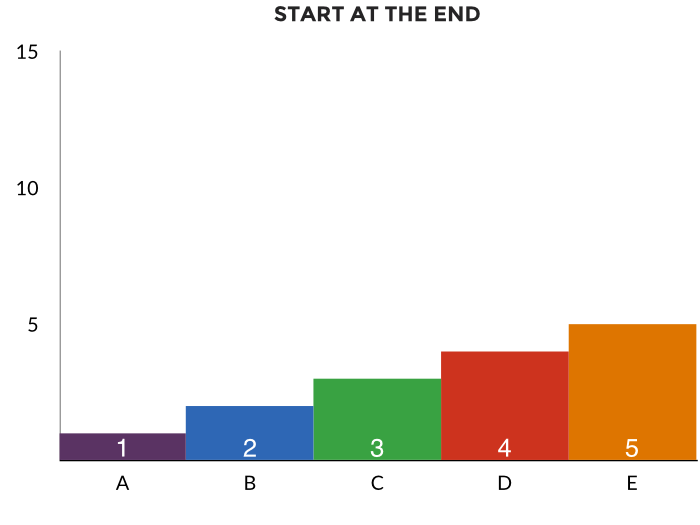
By contrast, in the backwards version the difference between part A and part E is only four. So you’ll have played the final part just a couple times more, but overall the differences are small. Your preparation will be much more even. The result: your piece of music will become slightly easier towards the end, instead of much harder.
3. It's more fun and motivating
As we’ve seen, in the start-at-the-start version, you practice the beginning of a piece more than the end. So when you play the whole piece, it gets harder and harder as you move further into the song. But with the backwards strategy, things get easier and easier as you go along. It’s like rolling down hill.
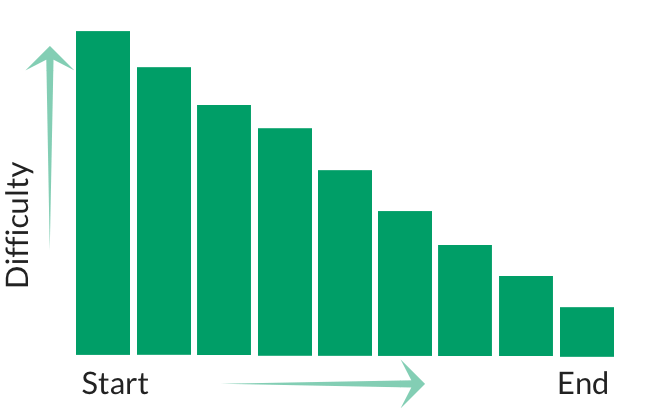
To me, this makes this approach more fun, motivating and much easier to stick to than both forwards approaches.
Every time you get a new part right, you get the kick of playing the piece through to the end. It’s like a little ‘reward’ you get every time you master a new bit of the song.
But when you study from the start to to the end, every time you get a new part right, you’re met with something you don’t know and you have to stop in the middle of the piece. Not much of a reward. I suspect this is the reason you often end up repeating the parts you already know a bunch of times, instead of focusing on the new part that you actually need to practice. You want to feel that flow of going through the piece. You want to make music.
This desire is fulfilled in the backwards strategy, because you automatically switch between the fun of playing some music and the hard work of studying. Between playing the whole thing and mastering a new part.
Only one way to find out...
All of this might sound a bit theoretical. All I can say is: take a solo, chord progression or something else that you’re working on and try it. See how this backwards strategy works for you. Even if it’s efficient and effective, what matters most in the end is your experience.
Personally, I really like this approach and if you do too, it’s a great tool to have in your toolbox to memorise music more quickly, practice songs efficiently and simply learn more music in less time. So give it a shot!
Become an All Access Member
Get access to All Courses and...
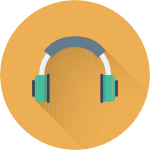
Train Your Ears
Ear training should help you in everyday playing. So instead of doing dry exercises, you’ll be figuring out real music by ear. So you’ll develop your ears, while learning tons of cool songs.

Learn Music Theory
Take super practical theory lessons, made specifically for guitar players. They’ll help you to navigate the fretboard, communicate with band mates and understand how the music you love is constructed.
Develop your Musicality
All courses on StringKick focus on tapping into and developing the musician inside you. By strengthening these skills, your playing will start to feel easier and more natural.


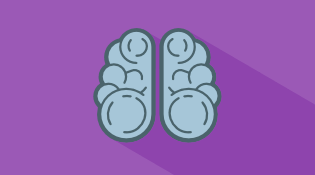

![Title image for How to Write a Song [Step-by-Step Guide]](https://www.stringkick.com/wp-content/uploads/2020/04/Songwriting-Title-Image-v1.png)

